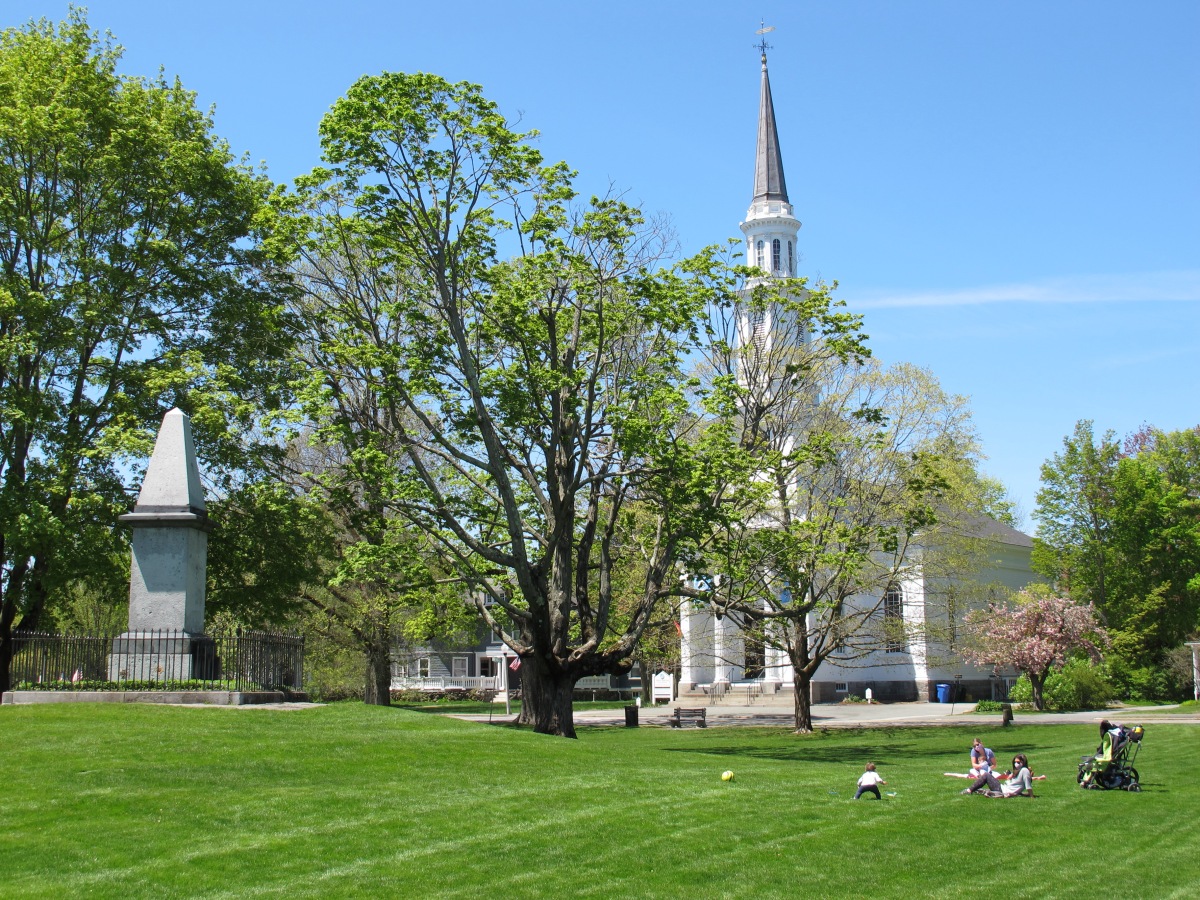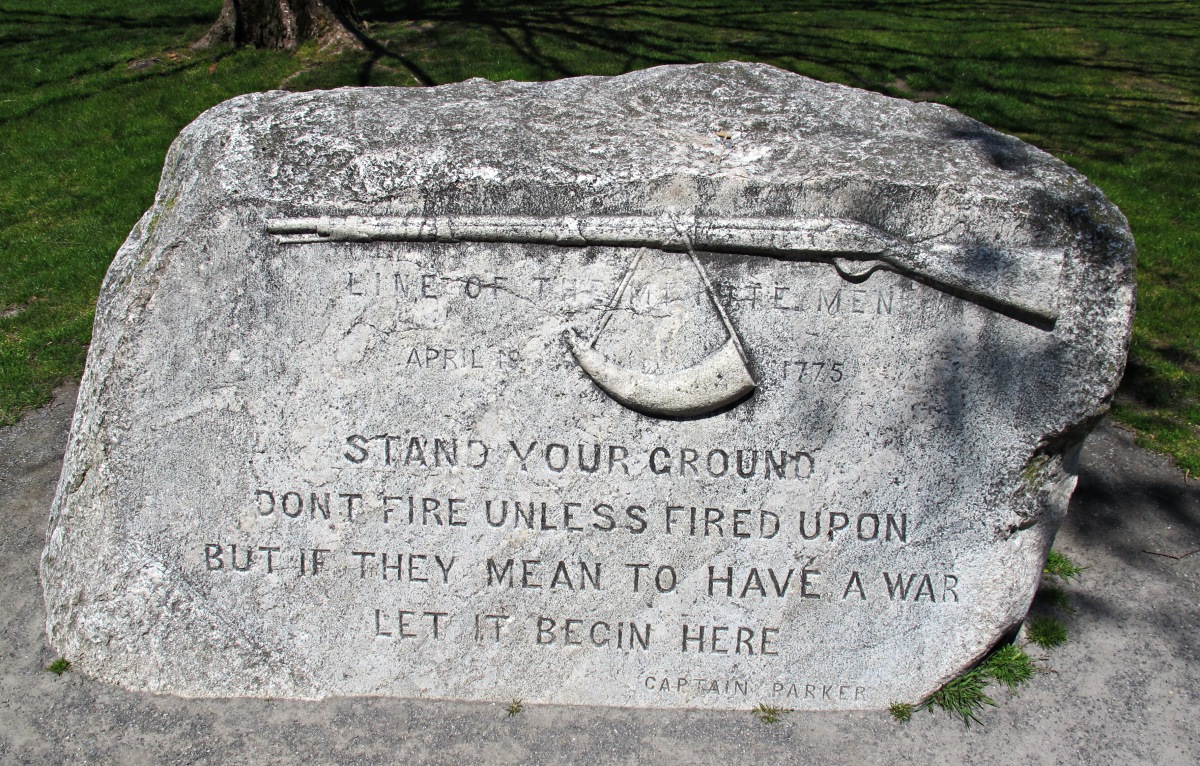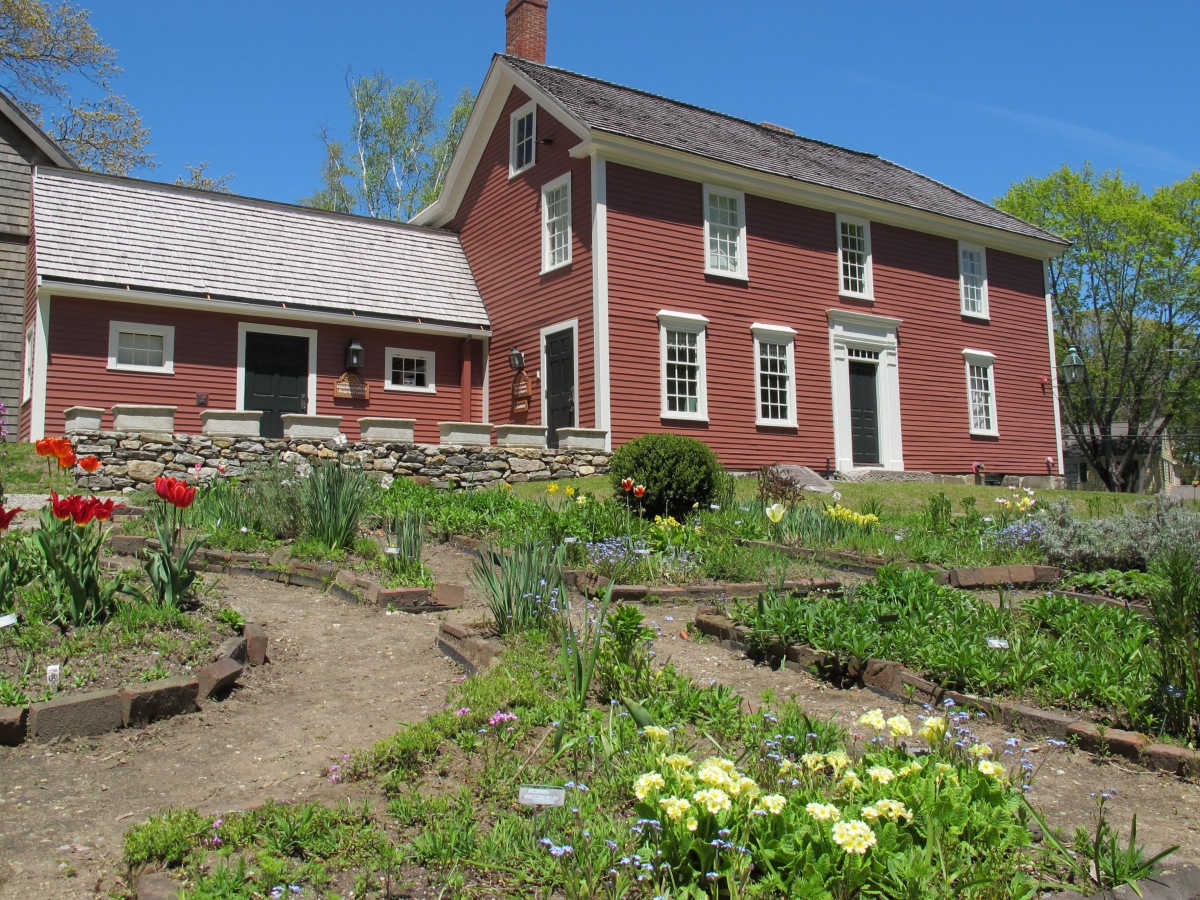Lexington, Massachusetts
Lexington was the home of the first Minutemen to die from British bullets in the Revolutionary War. It's now a historic, picturesque suburb of Boston.
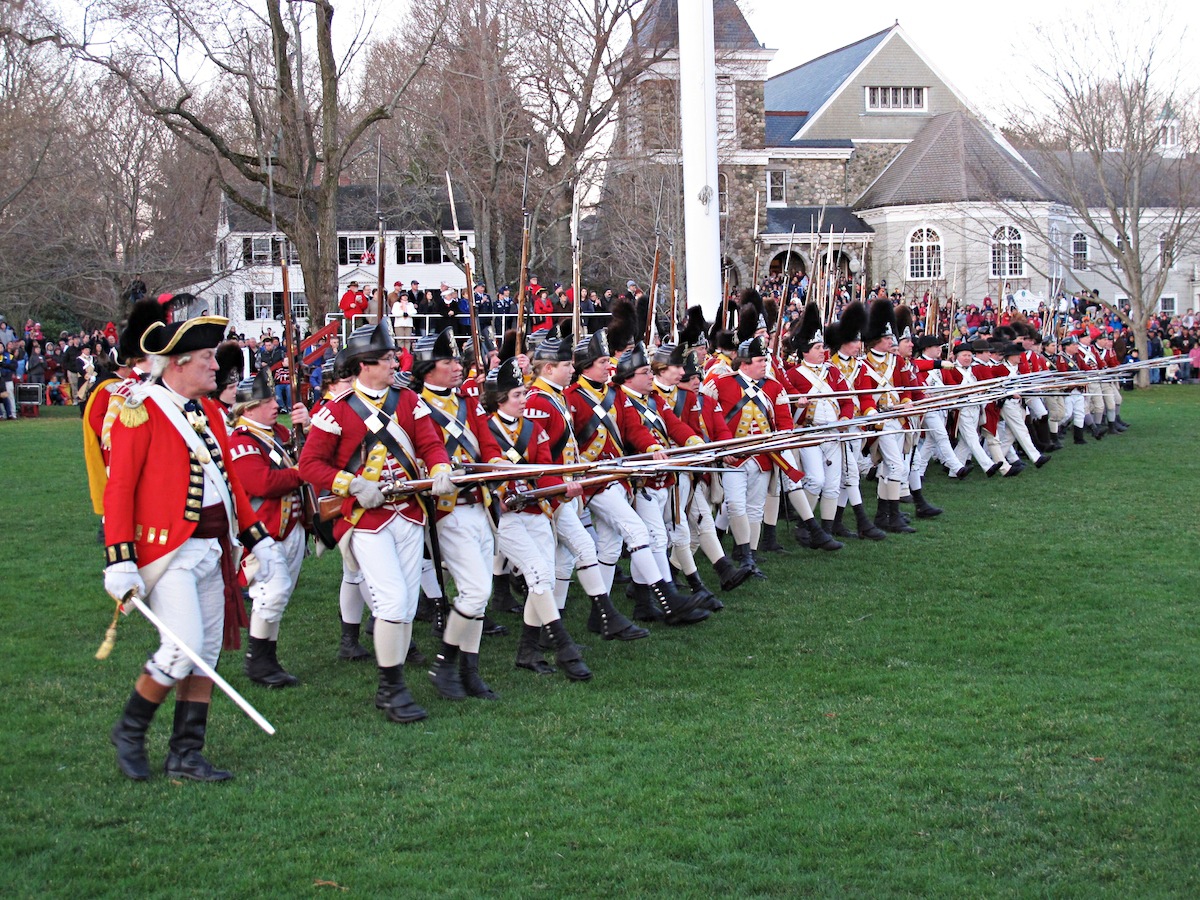
Redcoats advance toward the Minutemen on Lexington Green on Patriots Day.
Lexington, Massachusetts is a pleasant, prosperous suburb of Boston with a justifiable pride in its Revolutionary War role. You can visit Lexington's Battle Green, where the first shots of the war were fired, and even witness a re-enactment of the battle at dawn on Patriots Day (April 19th or thereabouts) each year.
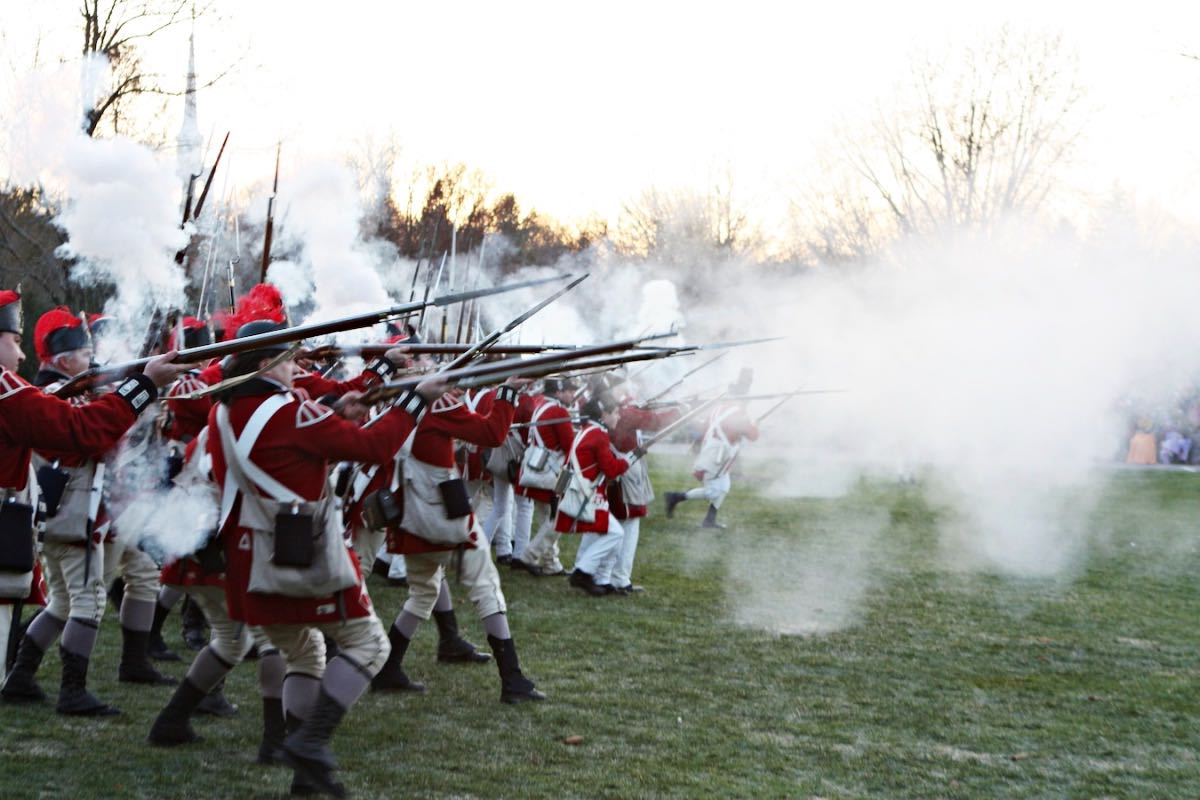
The smoke of battle as Redcoats open fire on the Minutemen.
Lexington's Battle Green is at the northwestern end of Lexington's commercial center of cafés, restaurants, shops, offices, and the fine Cary Memorial Library with free wifi. Hotels are on the outskirts on the road to Concord. See below for Transportation information.
The best time to visit Lexington's historic sights is, before dawn on Patriots Day (third Monday in April) when the townfolk re-enact the famous battle with festivities, real musket fire, and fife-and-drum corps.
Map of Lexington Center
You can easily walk to most of the sights in Lexington Center, as well as to cafés, restaurants and shops.
Lexington Battle Green
As the Redcoats formed their line on Lexington Green, neither side wanted or expected a fight. The Minutemen, obviously outnumbered, drew up in parade order (not defense or attack) and confronted the Redcoats but did not block the road to Concord, the Redcoat's goal. The Minutemen were ordered "not to fire unless fired upon," but taunts and insults were exchanged, a shot rang out—it's still not known from which side—and the battle followed. When the smoke cleared, eight Minutemen lay dead, with more injured. With difficulty the British officers regained command of their troops and ordered them to continue their march toward Concord, having suffered only one casualty.
Lexington Green looked much different in 1775 than it does today. The colonial meetinghouse (church building) was located near where the Minuteman statue stands today. Because it was mid-April on the day of the battle, and because the Green was in the center of town traffic, it may have been pretty muddy rather than "green."
Minuteman Statue
The Lexington Minuteman (1900), a statue by English sculptor Henry Hudson Kitson (1863-1947), stands ready as you approach Lexington's Battle Green at 1625 Massachusetts Avenue (map). The grassy 2.5-acre (1-hectare) public park is where the 77 to 80 Lexington Minutemen formed their line in opposition to the 700 British regular troops sent from Boston to confiscate colonial military weapons and stores said to be hidden at Concord.
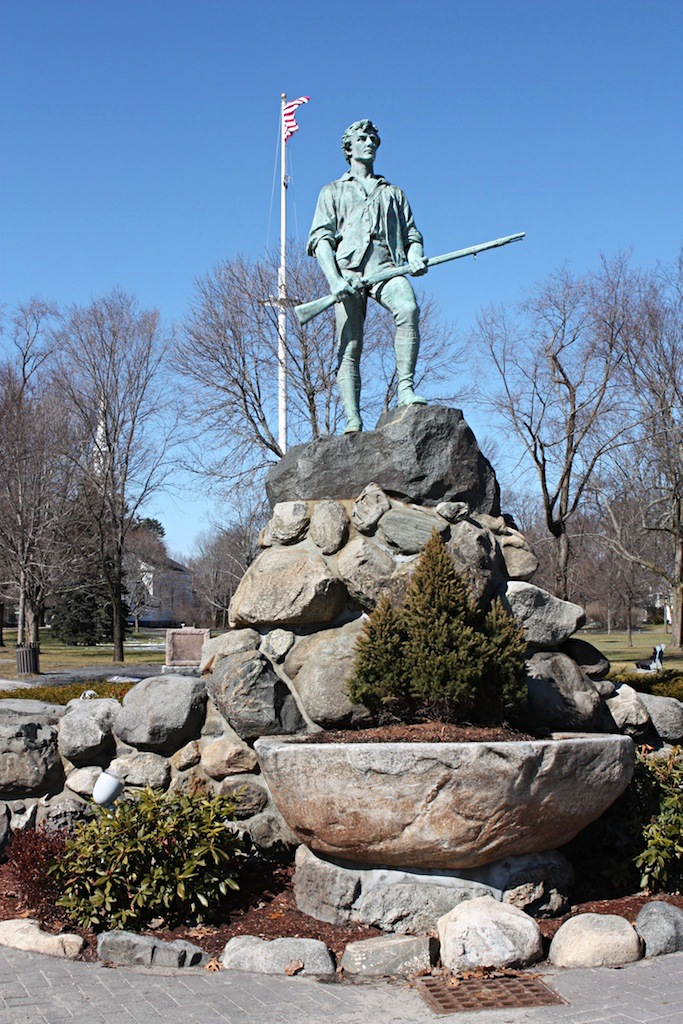
The Lexington Minuteman, by Henry Hudson Kitson.
Although the Minutemen who died on Lexington Green in 1775 were not the first Americans to die for their country (victims of the Boston Massacre hold that honor), nor even the first to offer spirited resistance as the Minutemen at Concord did, the eight Minutemen who fell on Lexington Green served their country well, for without the casualties at Lexington, the Minutemen at Concord might not have been determined to offer strong resistance to the British force.
Stone Pulpit
Behind the Minuteman statue to the northwest, a stone pulpit stands at the spot where the colonial meetinghouse (church building) stood from 1692 to 1846.
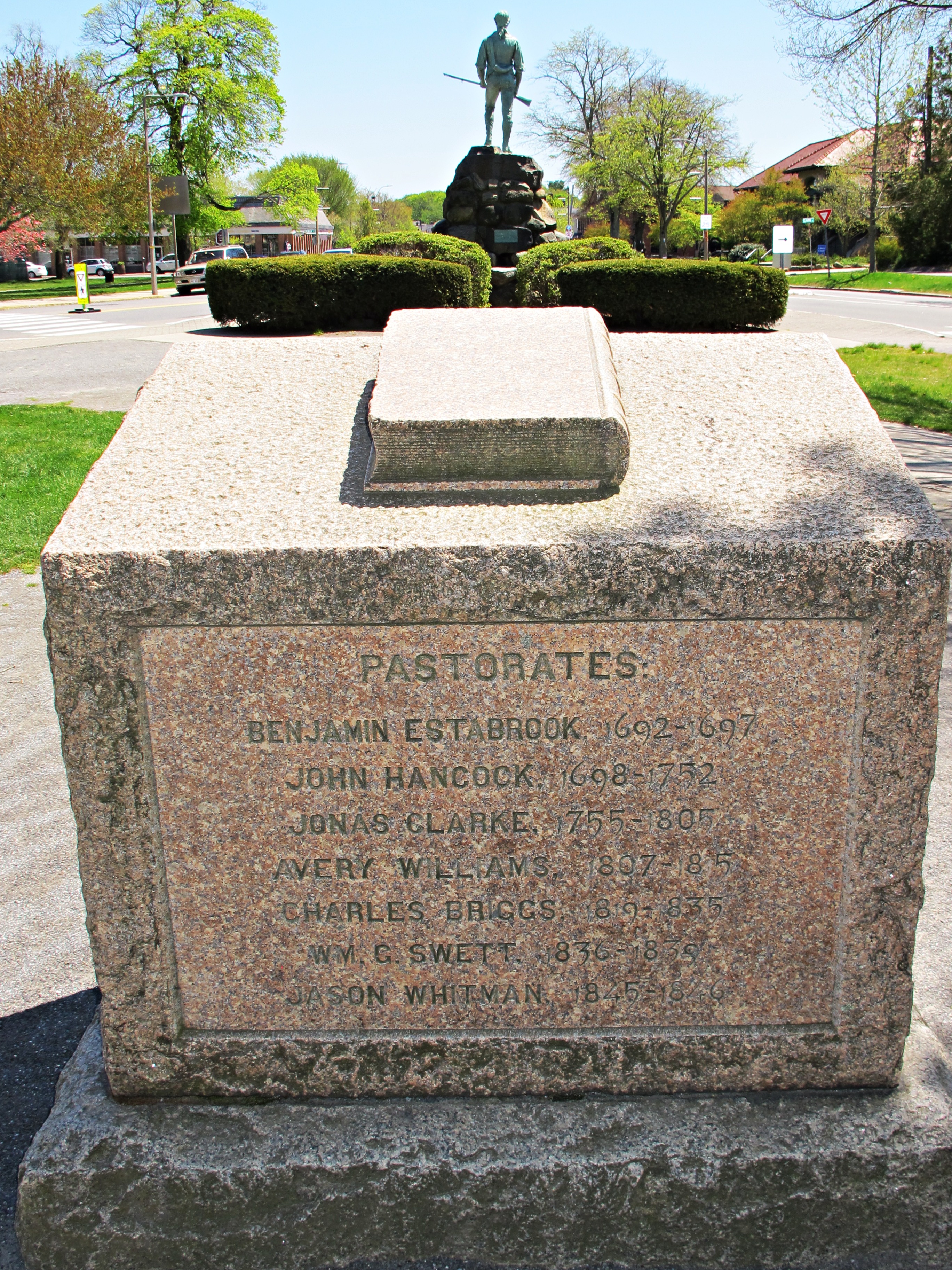
The stone pulpit marking the location of the church meetinghouse.
Nearby, a plaque on a boulder marks the spot where the Old Belfry stood. On April 19, 1775, its bell called the Minutemen to action. A replica stands in Belfry Hill Park southwest of the Minuteman statue, reached via Clarke Street (map).
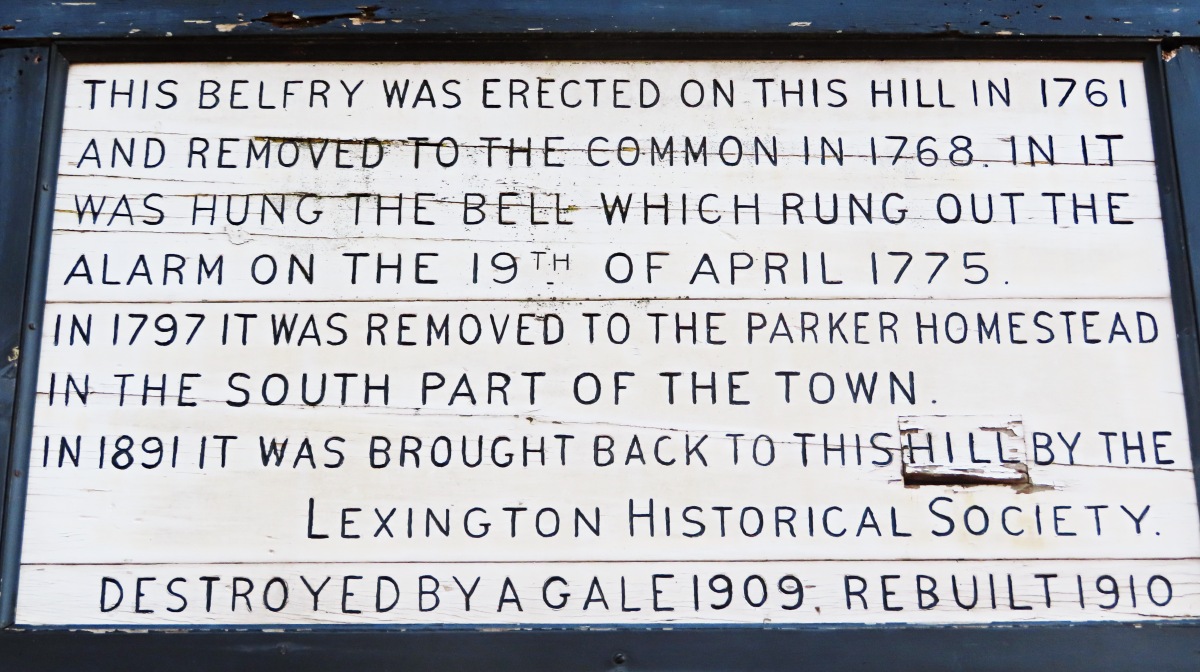
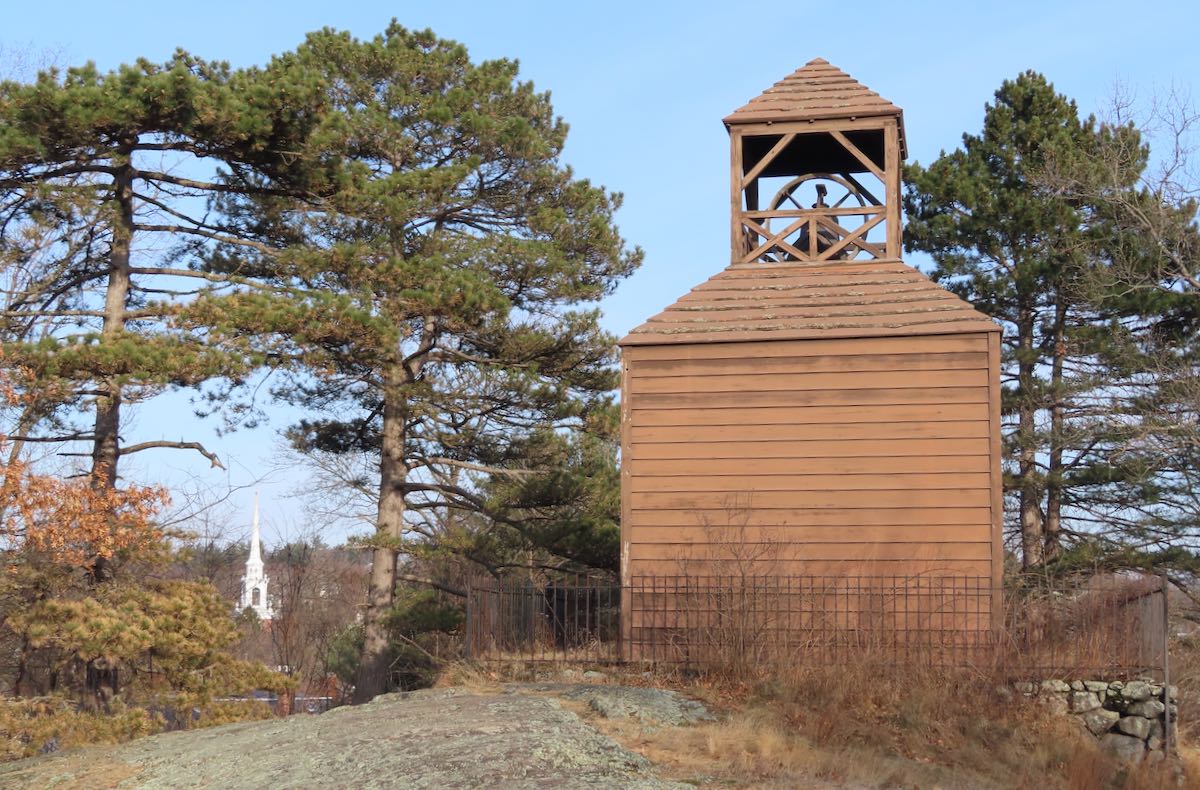
Replica of the Old Belfry, now on Belfry Hill.
The Revolutionary Monument
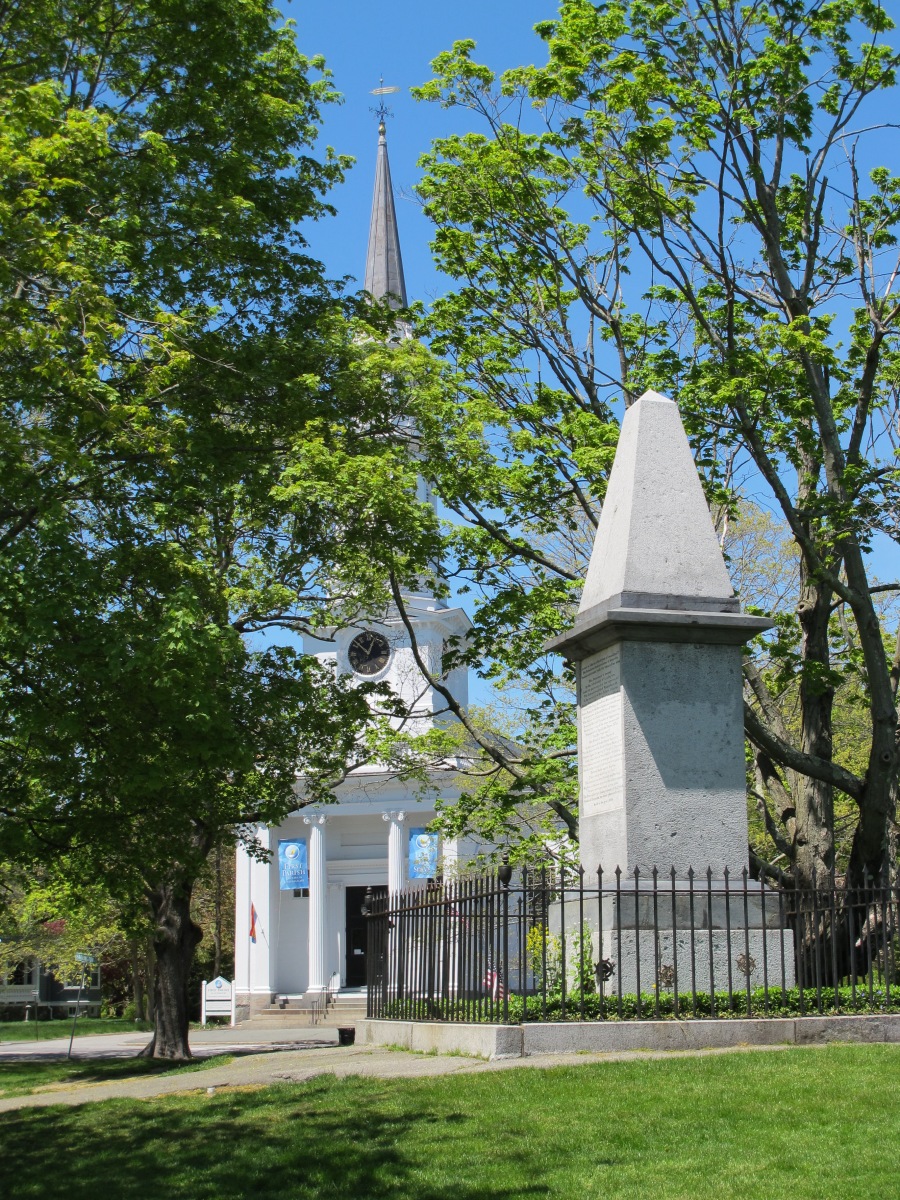
The Revolution Monument (1799) on Lexington's Battle Green.
Northwest of the stone pulpit on the western side of the Green rises the obelisk of the Revolutionary Monument (1799), marking the approximate western end of the Minutemen's formation. Beside it in the enclosure lie the remains of seven of the eight Minutemen who died in the battle.
On the other side of the Green, this boulder marks the eastern end of the Minutemen's formation:
Memorial to the Lexington Minutemen
Across Bedford Street from the eastern side of the Green, just to the north of Buckman Tavern, is the Memorial to the Lexington Minute Men (1948) by Boston sculptor Bashka Paeff.
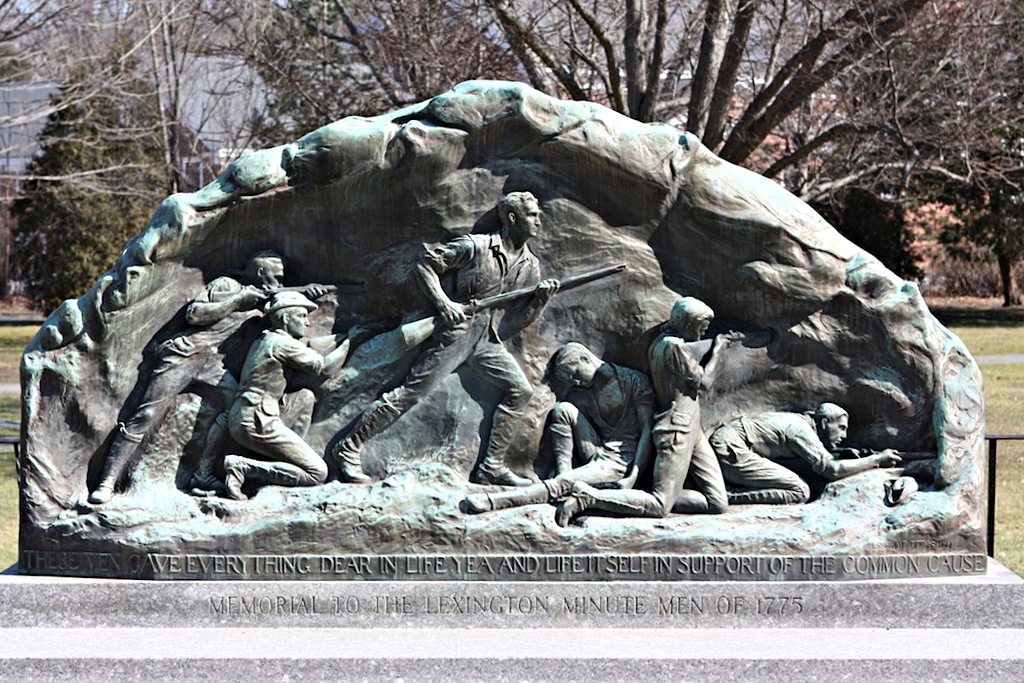
"These men gave everything dear in life yea and life itself in support of the common cause."
Prince Estabrook Plaque
Prince Estabrook (1741-1830), an enslaved man in the household of Benjamin Estabrook of Lexington, was a private in the Lexington Minutemen and answered the call on April 19, 1775. In the battle, he was wounded in the shoulder, but recovered from his wound and went on to fight with the Continental Army in later battles of the Revolutionary War. Emancipated after his military service, Estabrook apparently remained in the household of Benjamin Estabrook and died, aged about 90, in Ashby, Massachusetts, where he is buried. A plaque on a boulder on the west side of Buckman Tavern honors his service and that of other African-Americans as soldiers of the Revolution.
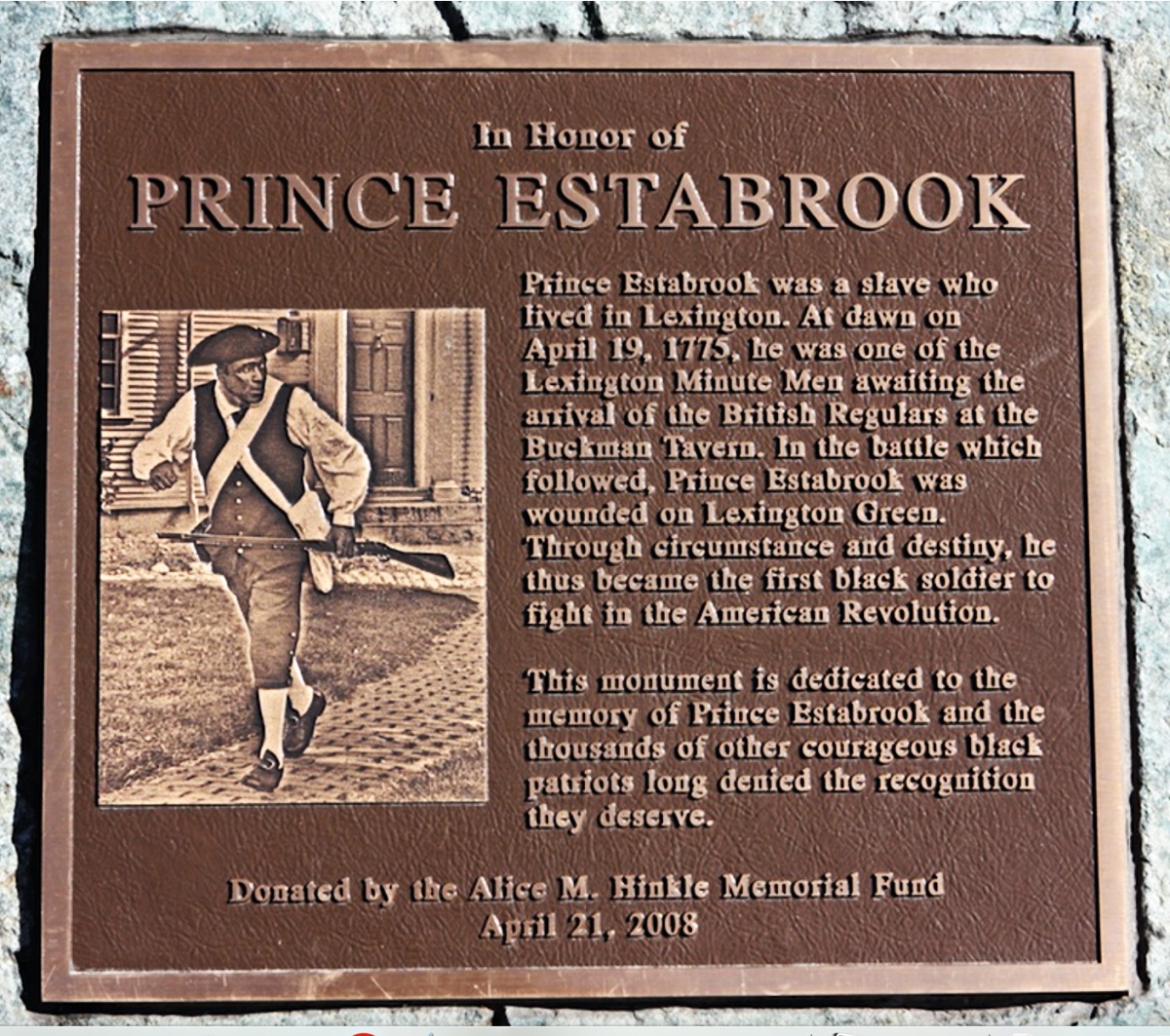
The Prince Estabrook plaque, honoring the service of African-American Revolutionary War soldiers.
Historic Taverns & Houses
The Lexington Historical Society maintains several historic houses and taverns dating from revolutionary times: Buckman Tavern, Munroe Tavern, and Hancock-Clarke House.
Buckman Tavern
Of the houses, Buckman Tavern (1709), 1 Bedford Street facing Lexington Green, is the most important. Here, in the taproom, many of the Minutemen waited out the time between that first midnight call to muster and the final arrival of the British forces at daybreak. After the battle, the wounded were brought here and laid out on the tables for treatment.

After they answered the pre-dawn call, Minutemen gathered in Buckman Tavern to plan strategy.
Tours of the historic building are given by guides well versed in their subject, which not only encompasses the events of the battle, but ranges much more widely, covering a great number of topics on life in the colonies at the time of the Revolution. They'll tell you about the construction of the tavern; about the people who came there to stay, or to have a drink, or for a reception or tea; what and how they ate and drank, how they cooked, slept, and kept warm in unheated rooms.
The tavern has an excellent collection of utensils, tools, and implements from the period, "time- and labor-saving devices" that show a good deal of Yankee ingenuity. The tour is well worth the price of admission. The tavern is located opposite the Common and has a gift shop.
Munroe Tavern
Munroe Tavern (1695), 1332 Massachusetts Avenue (map), was to the British what Buckman Tavern was to the Colonials: a headquarters and a place to care for the wounded after the battle. Today it's furnished with antiques and battle mementoes and is open to the public on the same basis as Buckman Tavern. It's a walk (or a short drive) from Battle Green, about seven blocks southeast along Massachusetts Avenue; the tavern will be on your right.
Hancock-Clarke House
The third significant house is the Hancock-Clarke House (1698), 500 yards (483 meters) north of Buckman Tavern at 36 Hancock Street (map), the parsonage of the Reverend Jonas Clarke at the time of the battle. It was with Clarke that John Hancock and Samuel Adams, the two "rabble-rousers" most wanted by the British authorities, hid themselves during the uncertain days before the battle.
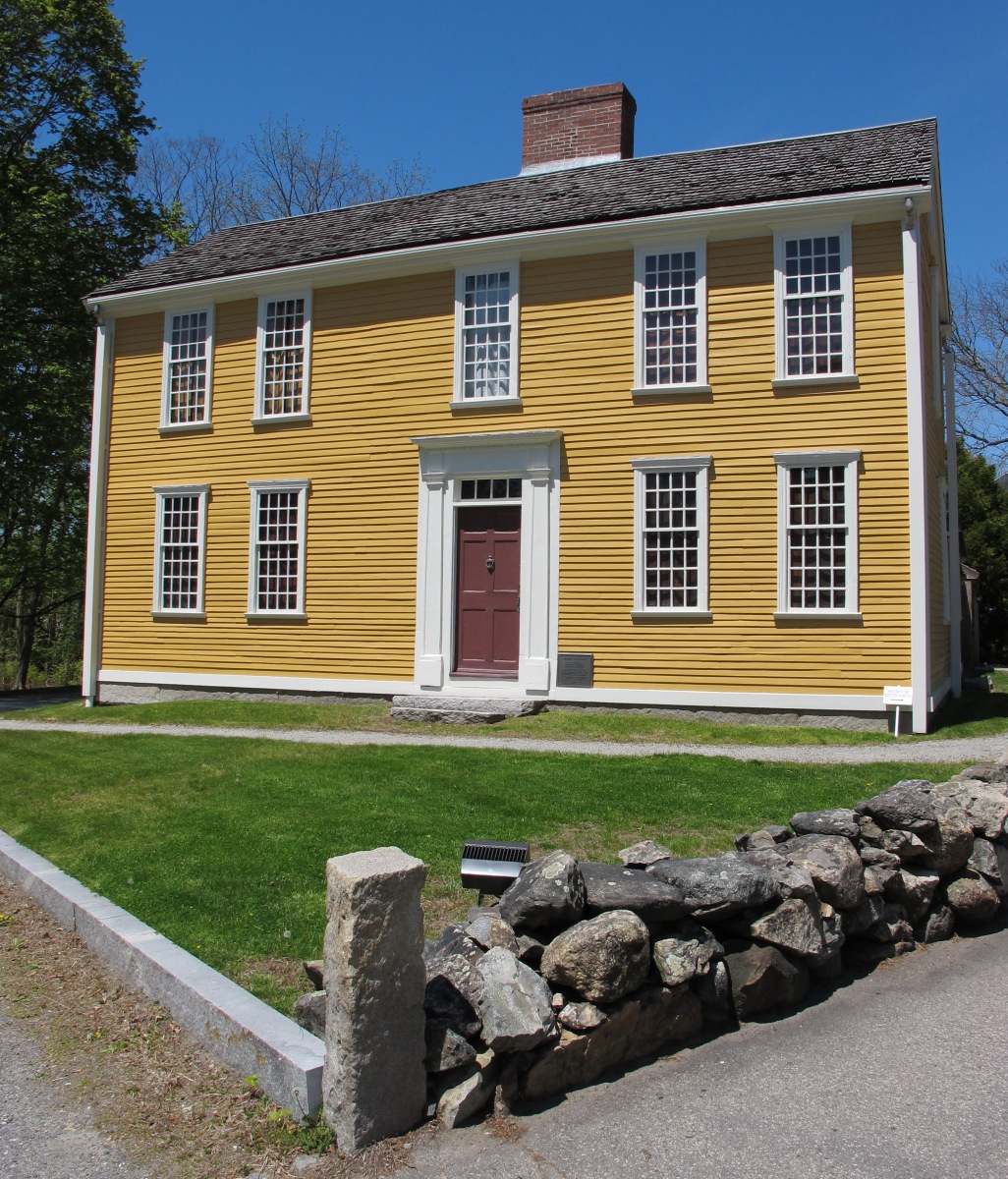
Here's where John Hancock and Samuel Adams sheltered before the Redcoats marched out from Boston.
Clarke's house was the goal of Paul Revere when he heard of the British plan to march into the countryside. Revere actually came to Clarke's house twice to warn Adams and Hancock: on April 15, just after hearing that the British were about to do something, and again on April 18, the night the British troops moved out.
Ye Olde Burying Ground
Several other sights in Lexington are worth a look. Colonial gravestones are the attraction at Ye Olde Burying Ground, 1965 Massachusetts Avenue (map), just off Battle Green behind the First Parish in Lexington meetinghouse (church) at 7 Harrington Road, just off Lexington Battle Green. The oldest gravestone dates from 1690.
The Battle of Lexington Mural
Another way to get into the spirit of the day of battle is to visit Cary Memorial Hall, 1605 Massachusetts Avenue (map), several blocks southeast of Battle Green along Massachusetts Avenue, between the town offices and the police station. Here you can see Henry Sandham's famous mural The Birth of Liberty portraying the battle of Lexington, and also statues of John Hancock and Samuel Adams.
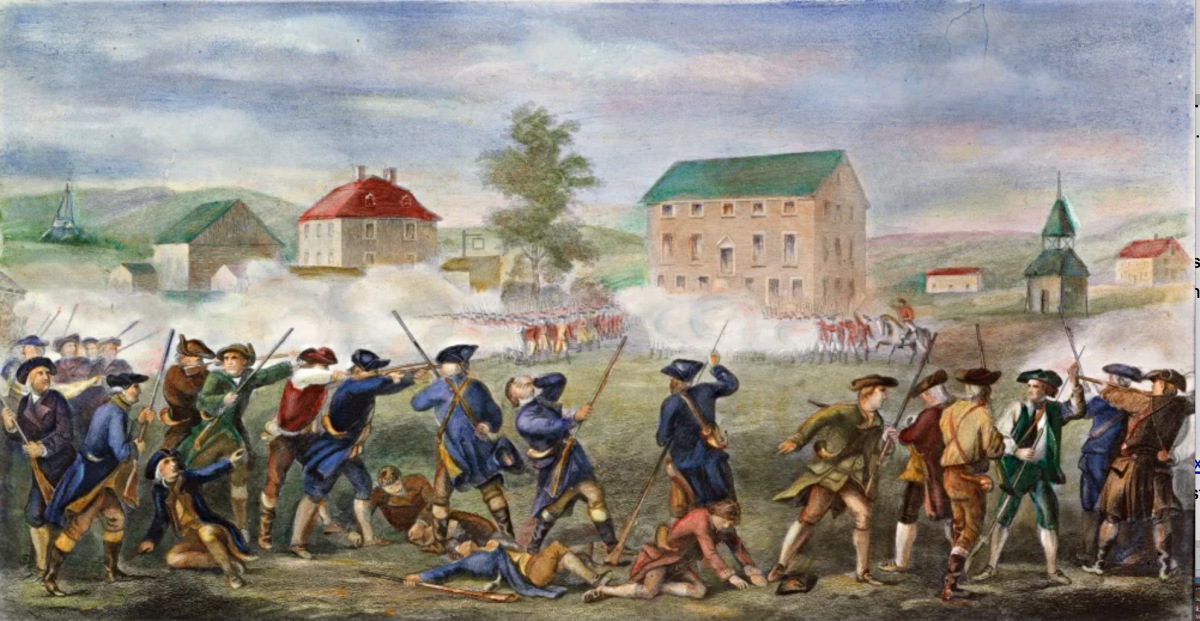
The Birth of Liberty by Henry Sandham (1842-1910).
Transportation
Lexington is 15 miles (24 km) northwest of Boston; Concord is 22 miles (35 km) northwest of Boston. The distance between Concord and Lexington is 7 miles (11 km). You can go easily from Boston and Cambridge to Lexington by car, bike, or subway and bus; or by car, bike or Commuter Rail train to Concord.
Car
Coming from Boston in a car, follow MA Route 2 westbound to Exit 129B, then 1 mile (1.6km) north along Pleasant Street, and 2.1 miles (3.4km) west on Massachusetts Avenue to Battle Green at 1625 Massachusetts Avenue (map).
Bus
Take the MBTA Red Line subway to the northwestern terminus at Alewife Station, then MBTA Bus 62 or 76 from Alewife to Lexington Center (Massachusetts Avenue at Depot Square or Clarke Street stops). More...
Bicycle
The Minuteman Bikeway from Boston and Cambridge passes right through the center of Lexington behind Buckman Tavern and the Visitor Center on its way to Bedford and, continuing along the Reformatory Branch Trail or Battle Road Trail, to Concord. From Alewife MBTA station to Lexington Battle Green is 6.5 miles (10.5km); from Battle Green to Concord Center is 8 miles (13km). You can take your bike on a bus (see above) if you prefer.
To visit both Lexington and Concord by bike, follow the Minuteman Bikeway to Lexington, then the Reformatory Branch Trail or Battle Road Trail to Concord, then take your bike on an MBTA Commuter Rail Fitchburg Line train from Concord to return to Cambridge and/or Boston. More...
Where to Stay
Lexington has a luxury inn, the Inn at Hastings Park, an eight-minute walk west of Battle Green, and several good hotels—Aloft and Element—on Marrett Road, two miles (3.2km) west of Battle Green on the road to Minute Man National Historical Park and Concord.
More Information...
Lexington's Visitors Center is in the park at 1875 Massachusetts Avenue, just off Lexington Battle Green and next door to Buckman Tavern, offering maps, brochures, tours, answers to questions, public restrooms (outside) and a water fountain (inside).
The National Park Service has organized most of the interesting historical sites in Lexington and Concord into Minute Man National Historical Park. You can download or pick up the Park Service's Minute Man maps at the main Minute Man Visitor Center, 210 North Great Road, Lincoln MA.
